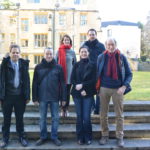Earlier this month, the Nomadic Empires Project hosted a workshop on the Alans—the medieval communities of the Northern Caucasus—and the Gates of the Alans—a system of fortification erected in order to control one of the major passageways through the Caucasus range that “divided” the frontier groups, such as the Alans, as well as the nomadic empires of the Northern Steppe from the territories of the large sedentary empires such as Sasanian Iran and the Islamic Caliphate.

Professor Dmitry Korobov, the Head of the Department of Theory and Methods, Institute of Archaeology, Russian Academy of Sciences gave a presentation titled “Early Medieval Fortifications and Land Use in the Northern Caucasus.” Korobov’s extensive archaeological research in the Northern Caucasus, the results of which he shared with the group, allowed him to paint a portrait of the medieval Alans and their way of life. He described their habitation and fortification sites and strategies, explained the system of their agro-pastoral economy and landuse, the role of long-distance trade and various religious beliefs based on their way of life and death. Korobov also presented evidence for the fluctuating political organization and cultural resilience of the Alans as a frontier people, who used their own strategies of dispersed or more unified settlements at different periods of history as their communities had to negotiate their position between the nomadic and sedentary empires on both sides of the Caucasus.
The precarious nature of life at the imperial frontier surrounded by the lands of various “hostile” people known from the medieval textual sources was discussed by Professor Eberhard Sauer, Edinburgh University’s School of History, Classics & Archaeology, in his presentation on “The Gate of the Alans“. Sauer shared the results of his multi-disciplinary archaeological project at this famous fortress which is currently located on the border between Georgia and Russia. He talked about the difficulties of maintaining a guarded fortification system in that remote part of the Caucasus, which had a harsh climate, sporadic food supplies, and experienced never-ending military attacks from the North and South. The diversity of the frontier population is another puzzling trait supported by archaeological evidence—the evidence that makes it difficult to understand who controlled this major fortress at different times in medieval history, as people moved and material culture was increasingly widely shared across the Caucasus.
These presentations provided the participants of the workshop with new and exciting information that resulted in the discussion of what role nomadic and sedentary empires and the frontier communities played in that region of the Caucasus, when the fortification system changed hands under different political circumstances through different phases of imperial power.